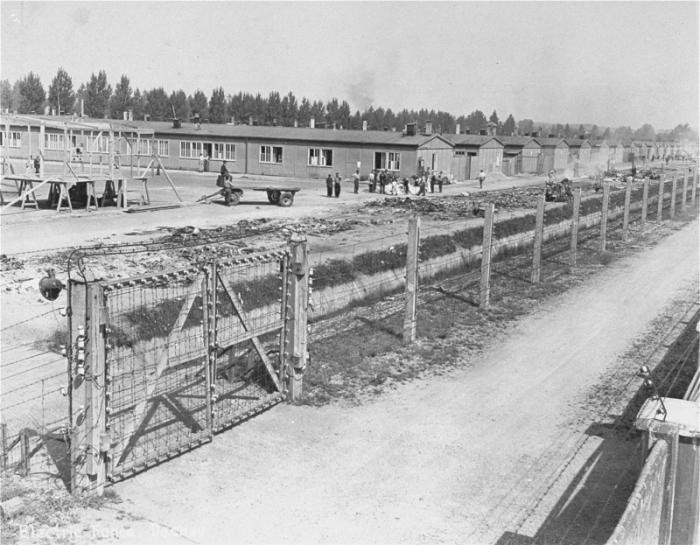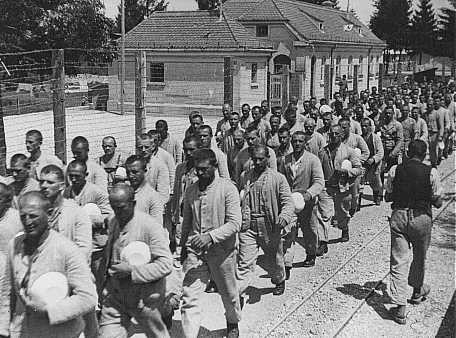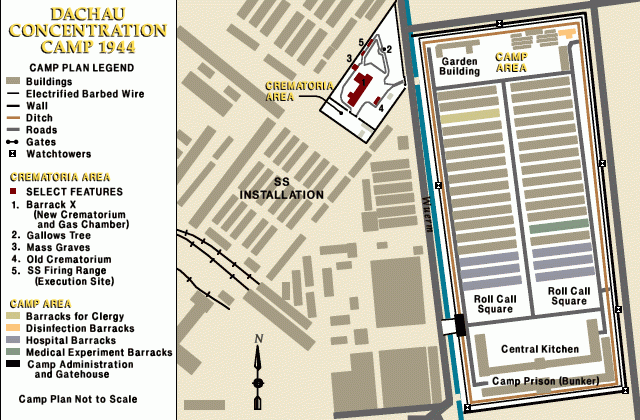
Dachau
Between 1933 and 1945, Nazi Germany and its allies established more than 44,000 camps and other incarceration sites (including ghettos). The perpetrators used these locations for a range of purposes. These purposes included forced labor, detention of people deemed to be "enemies of the state," and mass murder. Millions of people suffered and died or were killed. Among these sites was Dachau, the longest operating camp.
Key Facts
-
1
Established in March 1933, Dachau was the first regular concentration camp established by the Nazi government.
-
2
Dachau became a model for all later concentration camps and served as a training center for SS concentration camp guards.
-
3
The number of prisoners incarcerated in Dachau between 1933 and 1945 exceeded 200,000. Scholars believe that at least 40,000 prisoners died there.
Establishment of the Dachau Camp
The Dachau concentration camp was established in March 1933. It was the first regular concentration camp established by the National Socialist (Nazi) government. Heinrich Himmler, as police president of Munich, officially described the camp as "the first concentration camp for political prisoners."
It was located on the grounds of an abandoned munitions factory near the northeastern part of the town of Dachau, about 10 miles northwest of Munich in southern Germany. On March 22, 1933, the first prisoner transports arrived at the camp.
Prisoners in the Early Years of the Camp
During the first year, the camp had a capacity of 5,000 prisoners. Initially the internees were primarily German Communists, Social Democrats, trade unionists, and other political opponents of the Nazi regime. Over time, other groups were also interned at Dachau, such as Jehovah's Witnesses, Roma (Gypsies), gay men, as well as "asocials" and repeat criminal offenders. During the early years relatively few Jews were interned in Dachau and then usually because they belonged to one of the above groups or had completed prison sentences after being convicted for violating the Nuremberg Laws of 1935.

Expansion of the Dachau Camp Complex
In October, 1933, Dachau’s commandant, Theodor Eicke, introduced a system of regulations which inflicted brutal punishments on prisoners for the slightest offenses. When Eicke became Inspector of the newly established German concentration camp system, he ensured that the Dachau camp served as a model for all later concentration camps. It also became a training center for SS guards who were deployed throughout the concentration camp system.
In early 1937, the SS, using prisoner labor, began construction of a large complex of buildings on the grounds of the original camp. Prisoners were forced to do this work, starting with the destruction of the old munitions factory, under terrible conditions. The construction was officially completed in mid-August 1938 and the camp remained essentially unchanged until 1945. Dachau thus remained in operation for the entire period of the Third Reich.
The Dachau camp was a training center for SS concentration camp guards. The camp's organization and routine became the model for all Nazi concentration camps.
Jewish Prisoners in the Dachau Camp
The number of Jewish prisoners at Dachau rose with the increased persecution of Jews. On November 10–11, 1938, in the aftermath of Kristallnacht, almost 11,000 Jewish men were interned there. Most of the men in this group were released after incarceration of a few weeks to a few months, many after proving they had made arrangements to emigrate from Germany. Following the deportation of German Jews to ghettos and killing centers in the German-occupied east, the population of Jews in Dachau decreased dramatically. Jews again figured among its prisoner population when death marches brought thousands of prisoners from these camps in the east into the German interior.
Dachau Concentration Camp Sections

The camp was divided into two sections—the camp area and the crematoria area. The camp area consisted of 32 barracks, including one for clergy imprisoned for opposing the Nazi regime and one reserved for medical experiments.
The camp administration was located in the gatehouse at the main entrance. The camp area had a group of support buildings, containing the kitchen, laundry, showers, and workshops, as well as a prison block (Bunker). The courtyard between the prison and the central kitchen was used for the summary execution of prisoners. An electrified barbed-wire fence, a ditch, and a wall with seven guard towers surrounded the camp.
In 1942, the crematorium area was constructed next to the main camp. It included the old crematorium and the new crematorium (Barrack X) with a gas chamber. There is no credible evidence that the gas chamber in Barrack X was used to murder human beings. Instead, prisoners underwent "selection"; those who were judged too sick or weak to continue working were sent to the Hartheim "euthanasia" killing center near Linz, Austria. More than 2,500 Dachau prisoners were murdered in the gas chambers at Hartheim. In addition, mass executions by shooting took place, first in the bunker courtyard and later in a specially designed SS shooting range. Thousands of Dachau prisoners were murdered there, including at least 4,000 Soviet prisoners of war following the invasion of the Soviet Union in 1941.
Medical Experiments
Beginning in 1942, German physicians performed medical experiments on prisoners in Dachau. Physicians and scientists from the Luftwaffe (German Air Force) and the German Experimental Institute for Aviation conducted high-altitude and hypothermia experiments, as well as experiments to test methods for making seawater potable. These efforts aimed to aid German pilots who conducted bombing raids or who were downed in icy waters. German scientists also carried out experiments to test the efficacy of pharmaceuticals against diseases like malaria and tuberculosis. Hundreds of prisoners died or were harmed as a result of these experiments.
Forced Labor
Dachau prisoners were used as forced laborers. At first, they were employed in the operation of the camp, in various construction projects, and in small handicraft industries established in the camp. Prisoners built roads, worked in gravel pits, and drained marshes.
During the war, forced labor using concentration camp prisoners became increasingly important to German armaments production.
In the summer and fall of 1944, to increase war production, satellite camps under the administration of Dachau were established near armaments factories throughout southern Germany. Dachau alone had some 140 subcamps, mainly in southern Bavaria where prisoners worked almost exclusively in armaments works. Thousands of prisoners were worked to death.
Liberation
As Allied forces advanced toward Germany, German officials began to move prisoners from concentration camps near the front to prevent the capture of intact camps and their prisoners. Transports from the evacuated camps in the east arrived continuously at Dachau, resulting in a dramatic deterioration of conditions.
After days of travel, with little or no food or water, the prisoners arrived weak and exhausted, often near death. Typhus epidemics became a serious problem due to overcrowding, poor sanitary conditions, insufficient provisions, and the weakened state of the prisoners.
On April 26, 1945, as American forces approached, there were 67,665 registered prisoners in Dachau and its subcamps. More than half of this number were in the main camp. Of these, 43,350 were categorized as political prisoners, while 22,100 were Jews, with the remainder falling into various other categories. As Allied units approached, at least 25,000 prisoners from the Dachau camp system were force marched south or transported away from the camps in freight trains. During these so-called death marches, the Germans shot anyone who could no longer continue; many also died of starvation, hypothermia, or exhaustion.
On April 29, 1945, American forces liberated Dachau. As they neared the camp, they found more than 30 railroad cars filled with bodies brought to Dachau, all in an advanced state of decomposition. In early May 1945, American forces liberated the prisoners who had been sent on the death march.
Number of Prisoners
The number of prisoners incarcerated in Dachau between 1933 and 1945 exceeded 200,000. It is difficult to estimate the number of prisoners who died at Dachau. The thousands brought to the camp for execution were not registered before their deaths. Furthermore, the number of deaths that occurred during evacuation have not been assessed. Scholars believe that at least 40,000 prisoners died at Dachau.
Critical Thinking Questions
Investigate what target groups were imprisoned in Dachau in the early years of the Nazi regime. Why were they jailed and held?
How could the development of a system of concentration camps be a precursor to mass atrocity and genocide?

